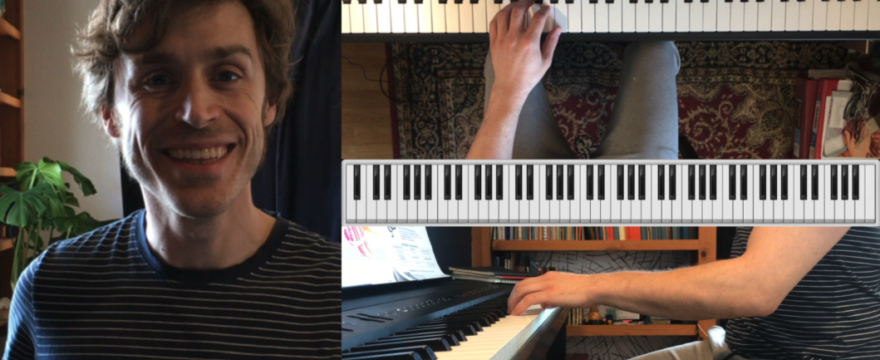Introducing Open Broadcasting Software and Friends, read in all its glorious formatted goodness here, with pictures!
Hello again dear readers, I hope this finds you well sprung, enjoying the promise of an outdoor and intermingled life soon if not already. Whatever may come of our slow, society wide emergence from the caves we call home, the fact is we’ve all learned too much to ever truly turn back, and for some of us we’ve learned enough to convert. Wherever you land on that spectrum, I’ve compiled yet another short list of some tech that helps me love my lessons as much as I ever have. I hope these invigorate your journey to digital mastery, and remember, if at first you don’t succeed your best bet is to turn it off and on again.
Open Broadcasting Software (OBS) – https://obsproject.com
Open-source software (read: free, but no helpline, just forums https://obsproject.com/forum/ ) that I use as my camera in Zoom, OBS brought a lot of fun & spontaneity back into my lessons. For recording & live-streaming by design, its ‘virtual webcam’ feature gives you the ability to send whatever mosaic(s) of video sources, apps, and images that you’ve composed in OBS as a single video feed to Zoom; a scene, to put it in the proper parlance.
It’s hard to overstate how much easier this makes building a digital classroom. Though we’ll have a chance to cover this in person at the June conference, I urge you to try it out on your own in the meantime. It’s surprisingly approachable, and if you’ve got a smartphone/tablet or two (https://youtu.be/Rv_ZG9X-Aus) kicking around then you can nearly run your own little production. It can be scary to start, but once you’re in it the clouds part and clarity shines through, I promise. Similar software includes ManyCam (https://manycam.com), which seems more polished but also has some kind of paywall.
Classroom Maestro: https://timewarptech.com/shop/music-software-apps/software/classroom-maestro/?v=7516fd43adaa
Made by the good people at Time Warp Technology (https://timewarptech.com/?v=7516fd43adaa), Classroom Maestro is a digital representation of a keyboard & pedal block, along with a dynamic notation tool that shows what’s played on the staff. It can analyze chords, recognize scale patterns, and more, all in a clean and very easy to use package. The star of the show in my opinion is the keyboard and pedal set, with keys that light up as you play them, and four different colors that correspond with different degrees of (sustain) pedal depression.
Built off of MIDI technology, this does mean their software is only available to those working with a digital instrument, but if you are then it’s extremely easy to configure. An excellent addition to OBS, it brings clarity to communication about complicated musical concepts online, with fun colors to boot! Similar software that seems worth checking out includes Chordie (https://chordieapp.com/) and MIDIculous (https://midiculous.com/), though I’ve yet to use either personally.
Teacher’s Atlas: https://cloud.pianoadventures.com/products/teacher-atlas/
If you use any of the Faber materials in your lessons, their burgeoning Teacher’s Atlas is an extremely helpful tool, either through the magic of screen sharing or as a web page ‘source’ within OBS. It has an extensive catalog, a variety of useful viewing formats including scroll, slide, and publication, and an intuitive zoom function to emphasize this or that measure or phrase.
The biggest help it offers is how quickly you’re able to communicate precisely where in the music you’re working, a welcome relief after the last year of playing musical battleship when trying to discuss anything in particular. With recent additions such as flash cards and sight reading samples, it seems to be on the right trajectory overall, and has been of most use for me in my lessons with younger students.
Adobe Scan: https://wsmta.org/wp-content/uploads/2020/09/2020-October-November-Clarion.pdf
A free app for iOS & Android devices, it makes turning sheet music, hand written notes, and handouts into PDFs a snap. This in turn makes annotating or using non-Faber music in the same way as I suggest above with the Teacher’s Atlas a significantly easier affair. At least you can open the file and screen share, at most you can incorporate your PDF reader (Preview on a Mac, for instance) into an OBS scene. In every case it’s easy, awesome, and free. What’s not to love?!
YouTube Studio: https://studio.youtube.com/
At some point YouTube, where you go to watch videos of cats, and YouTube, where you go to post videos of cats, became separated into two things, the latter being YouTube Studio. If you get into OBS and any or all the tech covered above, sooner or later you’ll find you’re inclined to make a follow up video after a lesson, or a general video demonstrating a technique you’re constantly revisiting, or any of the other million little things we tend to as teachers, students, and general lifelong-learners-about-town. YouTube is an excellent place to share videos like that. No not publicly, unless you want to, but at least as an unlisted video it can be a lifesaver for quick checkups, post-lesson synopses, and so on. No need to worry about file transfer, just upload the video, send a link, and marvel at connectivity in action.
